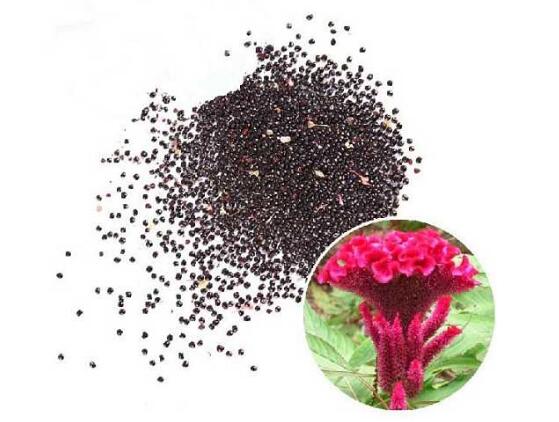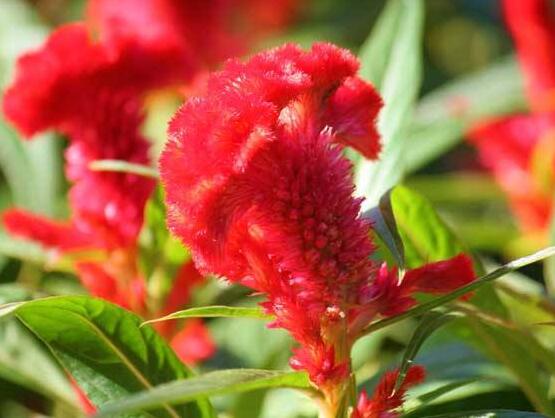How to sow the cockscomb, soak the seeds in advance / sow them with sand.
Among the breeding methods of cockscomb flower, sowing and breeding is a common one. Some people say that the survival rate of this method is not high. In fact, it is mainly because the sowing method is wrong. If you master the right method, the survival rate is still relatively high. So how does cockscomb flower sow? The following small series takes everyone to understand.
1. How to sow cockscomb flowers

1. sowing time
Choosing a right time to sow cockscomb is conducive to its growth, this time is generally selected in the spring or autumn of each year can be, the temperature of these two seasons is more appropriate, is more suitable for cockscomb growth.
2. soil selection
About how to sow cockscomb flower, soil selection is one of the more important links, although cockscomb flower for soil requirements are not too high, but choose a suitable soil can make its growth more robust, in the soil we can choose more fertile sandy soil, this soil drainage and good, for cockscomb flower growth has a lot of help.
3. drenching seed
After selecting the seeds of cockscomb flower, we need to soak the seeds in cold water for about 5-6 days, so that the seeds will germinate easily, and the seeds of cockscomb flower are relatively small, so it is best to mix them with sand when sowing.
4. sowing method
About how to sow cockscomb flowers, first we need to flatten the pot soil, and then mix the seeds with fine sand evenly on the soil surface, and then cover it with about 2cm of soil, and then water, in watering it is best to use a watering can to carry out, because cockscomb flowers seeds are small, if you water directly with a kettle, it is easy to wash away the seeds, this point we should pay attention to, 7-10 days after sowing can germinate.
II. Maintenance of cockscomb after sowing
After the germination of cockscomb flowers, we need to carry out follow-up maintenance on them, among which the more important ones are ornamental and watering management. Please see the following for specific management methods.
1. light management
Cockscomb is a light-loving flower, so it needs to keep enough light after germination, so that it can better carry out photosynthesis and grow faster.
2. watering management
Watering is an essential nutrient in the process of plant growth, cockscomb flower is no exception, but the amount of watering still needs to be controlled, generally to maintain a certain humidity of the soil can be, it is strictly prohibited to accumulate water, because seedlings are relatively fragile, if the accumulation of water, it is easy to directly rot to death.
How to treat seeds before sowing
How to treat seeds before sowing
Our common seeds, such as the seeds of Begonia and Impatiens, can be sown directly without treatment. Where the shell has oil wax seeds, such as magnolia, etc. can be used plant ash and water into a paste mixed into the seeds can be sown. Lotus, canna seed coat is hard, before sowing to bruise seed coat, with warm water soaked for 24 hours before sowing. The seeds of Prunus triloba are sown before freezing in winter, and watered thoroughly. The seed shell is frozen and cracked in winter, and it can germinate every two years in spring. All kinds of seeds need to be germinated before sowing, generally take 100 seeds, soak them in warm water and put them into a container with wet gauze, germinate at about 22℃, check the germination rate of seeds, so as to determine the sowing quantity. For woody flowers with thick seed coats, bud destruction is generally required before spring sowing to facilitate rapid and orderly emergence and high seedling rate. Germination more than the use of water immersion, stratification and other methods. 1. Water soaking for germination. Available 3 kinds of water temperature treatment: one is cold water soaking germination, water temperature above 0℃, suitable for thin seed shell seeds, such as wisteria, palm, Chinese plum, cedar and so on. Second, warm water soaking germination, water temperature 40℃~60℃, suitable for thick shell peony, peony, Bauhinia, maple poplar, Chinese sophora, Platycladus orientalis, money pine and so on. Third, hot water soaking germination, water temperature 70℃~90℃, suitable for seed coat hard seeds, such as acacia, locust, camphor tree and so on. Soaking water is about 3 times the amount of seed, pour water to stir, so that the seeds are heated evenly. When soaking seeds in hot water, stop stirring after the water temperature drops to natural temperature, soak for 13 days, take out seeds after water absorption and expansion, put them at 18℃~25℃ for germination, drench them with warm water for 1~2 times a day, and pay attention to gently turning them. After the seeds are broken, they can be sown.
2. Stratification germination. The so-called stratification germination is to mix three parts of wet sand and one part of seed, and keep moisture and refrigerate at 0℃~7℃. Magnolia, Michelia, Magnolia, Caprifoliaceae and seeds that germinate every other year need stratification to germinate. Here, for long-term dormant seeds or seeds sprouting every other year, the method of changing temperature germination can be adopted, that is, after soaking seeds, the temperature is kept at 25℃~30℃ during the day and the temperature is about 15℃ at night, and repeated for about 10~20 days, which can promote germination. Such as osmanthus, holly, coral trees, etc., can be used this method. How to promote the normal germination of seeds Different kinds of flowers have different germination periods due to different seed coat structures and physiological characteristics. Some flowers such as melon, balsamina, a string of red, etc., as long as they are sown at the right time, they can quickly emerge; while some flowers take several months or even longer to germinate, so artificial germination must be carried out to shorten the dormancy period of seeds. General knowledge of common sense in flower sowing and reproduction is introduced for your reference. First, the flower seeds selected for sowing should be full, disease-free, and mature individuals, so that healthy seedlings can germinate in due time. Second, seed treatment of different flowers seeds, it is appropriate to use different treatment methods. For seeds that are easy to germinate, soaking method can be used, such as a string of red seeds soaked in warm water at 40℃ for one day and night, washed clean and sown. Hard seeds such as asparagus, peony, murraya, daphne, hundred days red, etc., had better be soaked in warm water at 40℃ for 48 hours, and then sown in the soil, after 20 to 30 days, can sprout and grow. For pearl plum, bauhinia, brocade flower, etc., which have short dormancy period and are easy to germinate, they can be directly sown by soaking seeds in warm water at 40℃ to 60℃ for 24 to 48 hours. Some flowers, such as clove, wax plum and some autumn herbaceous flowers, need to undergo a period of low temperature (0℃ to 10℃) treatment to promote post-ripening, break the dormancy of seed embryos and germinate. The method is to mix the seeds with sand with a humidity of 60%, then put them into plastic bags, tie the mouth tightly, put them into flowerpots, and bury them in the ground 40 to 60 cm deep. The seeds can also be placed in a refrigerator at 3 to 5 ° C for 60 to 90 days and taken out for sowing in spring. It can also be sown in autumn, so that seeds can germinate in the spring of the next year after natural freezing in winter. Some flowers, such as tassel, pod, peony seeds, have the characteristics of double dormancy of radicle and hypocotyl, that is, its radicle also needs 1 to 2 months or longer high temperature stage of 25℃ to 32℃ to break dormancy. For these seeds, they should be mixed with wet sand before sowing, and then transferred to low temperature after a period of high temperature. After the treatment of variable temperature, spring sowing can germinate. Third, the choice of sowing time is generally annual flowers are not cold-resistant, open field planting can be sown after late frost, in order to promote its early flowering and more flowers, can be early in the greenhouse or cold bed seedlings. Biennial flowers and perennial flowers cold-resistant, seeds suitable for germination at low temperatures, appropriate autumn sowing. Most biennial flowers can also be replanted, considering flowering, according to the number of days required for each flower from germination to flowering, there are plans to sow. Greenhouse flower sowing has no strict seasonal restrictions, can be determined according to the flowering period. Seeds with small particles and loose thin skin, such as chrysanthemum, asparagus, balsamina, hundred-day red, campsia, etc., are suitable for sowing in late spring; seeds with large particles and solid skin or containing oil, such as rose, pomegranate, kumquat, magnolia, daphne, etc., are suitable for sowing in autumn and winter; seeds with small particles and thin skin and high temperature should be sown in time after maturity, such as melon and cyclamen, which should be sown in early summer, and pink, pansy, golden melon, etc. should be sown in late autumn. 4. Sowing methods are divided into open field sowing and pot sowing according to sowing land, and broadcast sowing, drill sowing and hole sowing according to methods. Water enough before sowing, cover the flowerpot with plastic film after sowing, or cover the flowerpot with glass sheet to preserve moisture and prevent the soil from being too dry to affect seed germination and emergence. Sowing depth should be about two and a half times the seed diameter. Fine seeds of cockscomb, chrysanthemum, melon, begonia, etc. should be mixed with fine sand or soil powder and sown. Seed germination period, should be sown water moisture, but not too much, in order to prevent reducing the soil temperature or rotten seeds and seedlings roots.
- Prev

How to reproduce Celosia cristata, the propagation method / sowing survival rate of Celosia cristata is high.
Celosia cristata is a kind of plant with high medicinal value, which has been introduced in the article on the efficacy and function of Celosia cristata, and because of this, there are many people who raise it in our country, but before breeding, first of all, we have to understand how it should reproduce. About how to reproduce cockscomb
- Next

How to cut bamboo plum, the propagation method of hanging bamboo plum / four points can be cut into the pot.
Diaozhumei is loved by people because of its unique branches and leaves, so some people want to raise more pots, so it is necessary to consider the problem of reproduction, so how to reproduce? The editor introduces to you two common and simple breeding methods of Prunus mume.
Related
- Fuxing push coffee new agricultural production and marketing class: lack of small-scale processing plants
- Jujube rice field leisure farm deep ploughing Yilan for five years to create a space for organic food and play
- Nongyu Farm-A trial of organic papaya for brave women with advanced technology
- Four points for attention in the prevention and control of diseases and insect pests of edible fungi
- How to add nutrient solution to Edible Fungi
- Is there any good way to control edible fungus mites?
- Open Inoculation Technology of Edible Fungi
- Is there any clever way to use fertilizer for edible fungus in winter?
- What agents are used to kill the pathogens of edible fungi in the mushroom shed?
- Rapid drying of Edible Fungi

